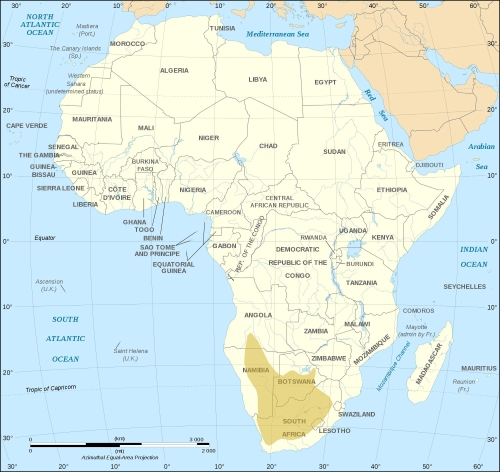 |
Alcelaphus caama
Bubalo del Cabo (Sp), Kaama (G), Bubale caama (F), Rooihartbees (Af). Most people call it Cape hartebeest, though red hartebeest probably is a better name, as its red color is unique among hartebeests and its range lies mainly outside the Cape region.
DESCRIPTION Shoulder height 48-50 inches (122-127 cm). Weight 330-350 pounds (150-160 kg).
The Cape hartebeest is a larger hartebeest with a long face and a high frontal pedicel. The general color is some shade of bright reddish brown. The forehead is black and there is a dark facial blaze that is interrupted by a lighter band between the eyes. There are blackish markings on back of neck, chin, shoulders, hips and legs, and a wide, yellowish-white patch on sides and lower part of the rump. The horns (both sexes) are thick and V-shaped when viewed from the front. They grow slightly out and back from the pedicel, then up and forward, and finally bend sharply backward.
DISTRIBUTION Much of Namibia, extending into southern Angola between the Cunene and Cubango rivers, and throughout the Kalahari region of Botswana. Vagrants occasionally wander into western Zimbabwe.
In South Africa it formerly occurred in the western Transvaal, in parts of the Orange Free State and Natal, and throughout Cape Province; however, it was exterminated by early European settlers except for a narrow strip in the Northern Cape near Botswana. Now widely reintroduced on government reserves and private ranches, especially in the drier regions. Once again a common species, with its numbers increasing.
REMARKS The Cape hartebeest is by far the most heavily hunted of the hartebeests, with most animals being taken from private ranches in Namibia and South Africa. Such ranch hunting is not necessarily easier or less sporting than hunting free-ranging animals from Botswana-in fact the opposite is likely to be true. Most ranch hartebeests are hunted regularly and are more likely to be wary and wild than those from the vast Kalahari, many of whom scarcely ever see a hunter.
|





